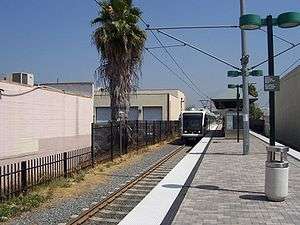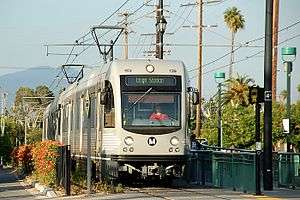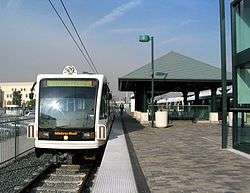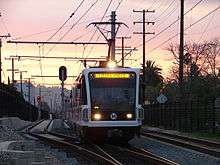L Line (Los Angeles Metro)
The L Line is a 31-mile (50 km)[3] light rail line running from Azusa to East Los Angeles via Downtown Los Angeles serving several attractions, including Little Tokyo, Union Station, the Southwest Museum, Chinatown and the shops of Old Pasadena. The line, which is one of six in the Metro Rail system, entered service in 2003 and is operated by the Los Angeles County Metropolitan Transportation Authority (Metro). The Gold Line serves 27 stations (including two subway stations).[3]
| L Line | |||||||||||||||||||||||||||||||||||||||||||||||||||||||||||||||||||||||||||||||||||||||||||||||||||||||||||||||||||||||||||||||||||||||||||||||||||||||||||||||||||||||||||||||||||||||||||||||||||||||||||||||||||||||||||||||||||||||||||||||||||||||||||||||||||||||||||||||||||||||||||||||||||||||||||||||||||||||||||||||||||||||||||||||||||||||||||||||||||||||||||||||||||||||||||||||||||||||||||||||||||||||||||||||||||||||||||||||||||||||||||||||||||||||||||||||||||||||||||||||||||||||||||||||||||||||||||||||||||||||||||||||||||||||||||||||||||||||||||||||||||||||||||||||||||||||||||||||||||||||||||||||||||||||||||||||||||||||||||||||||||||||||||||||||||||||||||||||||||||||||||||||||||||||||||||||||||||||||||||||||||||||||||||||||||||||||||||||||||||||||||||||||||||||||||||||||||||||||||||||||||||||||||||||||||||||||||||||||||||||||||||||||||||||||||||||||||||||||||||||||||||||||||||||||||||||||||||||||||||||||||||||||||||||||||||||||||||||||||||||||||||||||||||||||||||||||||||||||||||||
|---|---|---|---|---|---|---|---|---|---|---|---|---|---|---|---|---|---|---|---|---|---|---|---|---|---|---|---|---|---|---|---|---|---|---|---|---|---|---|---|---|---|---|---|---|---|---|---|---|---|---|---|---|---|---|---|---|---|---|---|---|---|---|---|---|---|---|---|---|---|---|---|---|---|---|---|---|---|---|---|---|---|---|---|---|---|---|---|---|---|---|---|---|---|---|---|---|---|---|---|---|---|---|---|---|---|---|---|---|---|---|---|---|---|---|---|---|---|---|---|---|---|---|---|---|---|---|---|---|---|---|---|---|---|---|---|---|---|---|---|---|---|---|---|---|---|---|---|---|---|---|---|---|---|---|---|---|---|---|---|---|---|---|---|---|---|---|---|---|---|---|---|---|---|---|---|---|---|---|---|---|---|---|---|---|---|---|---|---|---|---|---|---|---|---|---|---|---|---|---|---|---|---|---|---|---|---|---|---|---|---|---|---|---|---|---|---|---|---|---|---|---|---|---|---|---|---|---|---|---|---|---|---|---|---|---|---|---|---|---|---|---|---|---|---|---|---|---|---|---|---|---|---|---|---|---|---|---|---|---|---|---|---|---|---|---|---|---|---|---|---|---|---|---|---|---|---|---|---|---|---|---|---|---|---|---|---|---|---|---|---|---|---|---|---|---|---|---|---|---|---|---|---|---|---|---|---|---|---|---|---|---|---|---|---|---|---|---|---|---|---|---|---|---|---|---|---|---|---|---|---|---|---|---|---|---|---|---|---|---|---|---|---|---|---|---|---|---|---|---|---|---|---|---|---|---|---|---|---|---|---|---|---|---|---|---|---|---|---|---|---|---|---|---|---|---|---|---|---|---|---|---|---|---|---|---|---|---|---|---|---|---|---|---|---|---|---|---|---|---|---|---|---|---|---|---|---|---|---|---|---|---|---|---|---|---|---|---|---|---|---|---|---|---|---|---|---|---|---|---|---|---|---|---|---|---|---|---|---|---|---|---|---|---|---|---|---|---|---|---|---|---|---|---|---|---|---|---|---|---|---|---|---|---|---|---|---|---|---|---|---|---|---|---|---|---|---|---|---|---|---|---|---|---|---|---|---|---|---|---|---|---|---|---|---|---|---|---|---|---|---|---|---|---|---|---|---|---|---|---|---|---|---|---|---|---|---|---|---|---|---|---|---|---|---|---|---|---|---|---|---|---|---|---|---|---|---|---|---|---|---|---|---|---|---|---|---|---|---|---|---|---|---|---|---|---|---|---|---|---|---|---|---|---|---|---|---|---|---|---|---|---|---|---|---|---|---|---|---|---|---|---|---|---|---|---|---|---|---|---|---|---|---|---|---|---|---|---|---|---|---|---|---|---|---|---|---|---|---|---|---|---|---|---|---|---|---|---|---|---|---|---|---|---|---|---|---|---|---|---|---|---|---|---|---|---|---|---|---|---|---|---|---|---|---|---|---|---|---|---|---|---|---|---|---|---|---|---|---|---|---|---|---|---|---|---|---|---|---|---|---|---|---|---|---|---|---|---|---|---|---|---|---|---|---|---|---|---|---|---|---|---|---|---|---|---|---|---|---|---|---|---|---|---|---|---|---|---|---|---|---|---|---|---|---|---|---|---|---|---|---|---|---|---|---|---|---|---|---|---|---|---|---|---|---|---|---|---|---|---|---|---|---|---|---|---|---|---|---|---|---|---|---|---|---|---|---|---|---|---|---|---|---|---|---|---|---|---|---|---|---|---|---|---|---|---|---|---|---|---|---|---|---|---|---|---|---|---|---|---|---|---|---|---|---|---|---|---|---|---|---|---|---|---|---|---|---|---|---|---|---|---|---|---|---|---|---|---|---|---|---|---|---|---|---|---|---|---|---|---|---|---|---|---|---|---|---|---|---|---|---|---|---|---|---|---|---|---|---|---|---|---|---|---|---|---|---|---|---|---|---|---|---|---|---|---|---|---|---|---|---|---|---|---|---|---|---|---|---|---|---|---|---|---|---|---|---|---|---|---|---|---|---|---|---|---|---|---|---|---|---|---|---|---|---|---|---|---|---|---|---|---|---|---|---|---|---|---|---|---|---|---|---|---|---|---|---|---|---|---|---|---|---|---|---|---|---|---|---|---|---|---|---|---|---|---|---|---|---|---|---|---|---|---|---|---|---|---|---|---|---|---|---|---|---|---|---|---|---|---|---|---|---|---|---|---|---|---|---|---|---|---|---|---|---|---|---|---|---|---|---|---|---|---|---|---|---|---|---|---|
 | |||||||||||||||||||||||||||||||||||||||||||||||||||||||||||||||||||||||||||||||||||||||||||||||||||||||||||||||||||||||||||||||||||||||||||||||||||||||||||||||||||||||||||||||||||||||||||||||||||||||||||||||||||||||||||||||||||||||||||||||||||||||||||||||||||||||||||||||||||||||||||||||||||||||||||||||||||||||||||||||||||||||||||||||||||||||||||||||||||||||||||||||||||||||||||||||||||||||||||||||||||||||||||||||||||||||||||||||||||||||||||||||||||||||||||||||||||||||||||||||||||||||||||||||||||||||||||||||||||||||||||||||||||||||||||||||||||||||||||||||||||||||||||||||||||||||||||||||||||||||||||||||||||||||||||||||||||||||||||||||||||||||||||||||||||||||||||||||||||||||||||||||||||||||||||||||||||||||||||||||||||||||||||||||||||||||||||||||||||||||||||||||||||||||||||||||||||||||||||||||||||||||||||||||||||||||||||||||||||||||||||||||||||||||||||||||||||||||||||||||||||||||||||||||||||||||||||||||||||||||||||||||||||||||||||||||||||||||||||||||||||||||||||||||||||||||||||||||||||||||
Northbound train at Atlantic station | |||||||||||||||||||||||||||||||||||||||||||||||||||||||||||||||||||||||||||||||||||||||||||||||||||||||||||||||||||||||||||||||||||||||||||||||||||||||||||||||||||||||||||||||||||||||||||||||||||||||||||||||||||||||||||||||||||||||||||||||||||||||||||||||||||||||||||||||||||||||||||||||||||||||||||||||||||||||||||||||||||||||||||||||||||||||||||||||||||||||||||||||||||||||||||||||||||||||||||||||||||||||||||||||||||||||||||||||||||||||||||||||||||||||||||||||||||||||||||||||||||||||||||||||||||||||||||||||||||||||||||||||||||||||||||||||||||||||||||||||||||||||||||||||||||||||||||||||||||||||||||||||||||||||||||||||||||||||||||||||||||||||||||||||||||||||||||||||||||||||||||||||||||||||||||||||||||||||||||||||||||||||||||||||||||||||||||||||||||||||||||||||||||||||||||||||||||||||||||||||||||||||||||||||||||||||||||||||||||||||||||||||||||||||||||||||||||||||||||||||||||||||||||||||||||||||||||||||||||||||||||||||||||||||||||||||||||||||||||||||||||||||||||||||||||||||||||||||||||||||
| Overview | |||||||||||||||||||||||||||||||||||||||||||||||||||||||||||||||||||||||||||||||||||||||||||||||||||||||||||||||||||||||||||||||||||||||||||||||||||||||||||||||||||||||||||||||||||||||||||||||||||||||||||||||||||||||||||||||||||||||||||||||||||||||||||||||||||||||||||||||||||||||||||||||||||||||||||||||||||||||||||||||||||||||||||||||||||||||||||||||||||||||||||||||||||||||||||||||||||||||||||||||||||||||||||||||||||||||||||||||||||||||||||||||||||||||||||||||||||||||||||||||||||||||||||||||||||||||||||||||||||||||||||||||||||||||||||||||||||||||||||||||||||||||||||||||||||||||||||||||||||||||||||||||||||||||||||||||||||||||||||||||||||||||||||||||||||||||||||||||||||||||||||||||||||||||||||||||||||||||||||||||||||||||||||||||||||||||||||||||||||||||||||||||||||||||||||||||||||||||||||||||||||||||||||||||||||||||||||||||||||||||||||||||||||||||||||||||||||||||||||||||||||||||||||||||||||||||||||||||||||||||||||||||||||||||||||||||||||||||||||||||||||||||||||||||||||||||||||||||||||||||
| Other name(s) | Gold Line (current line, 2003–2020) After completion of Regional Connector in 2022: A Line (blue; Azusa-Long Beach) E Line (gold; East LA-Santa Monica) | ||||||||||||||||||||||||||||||||||||||||||||||||||||||||||||||||||||||||||||||||||||||||||||||||||||||||||||||||||||||||||||||||||||||||||||||||||||||||||||||||||||||||||||||||||||||||||||||||||||||||||||||||||||||||||||||||||||||||||||||||||||||||||||||||||||||||||||||||||||||||||||||||||||||||||||||||||||||||||||||||||||||||||||||||||||||||||||||||||||||||||||||||||||||||||||||||||||||||||||||||||||||||||||||||||||||||||||||||||||||||||||||||||||||||||||||||||||||||||||||||||||||||||||||||||||||||||||||||||||||||||||||||||||||||||||||||||||||||||||||||||||||||||||||||||||||||||||||||||||||||||||||||||||||||||||||||||||||||||||||||||||||||||||||||||||||||||||||||||||||||||||||||||||||||||||||||||||||||||||||||||||||||||||||||||||||||||||||||||||||||||||||||||||||||||||||||||||||||||||||||||||||||||||||||||||||||||||||||||||||||||||||||||||||||||||||||||||||||||||||||||||||||||||||||||||||||||||||||||||||||||||||||||||||||||||||||||||||||||||||||||||||||||||||||||||||||||||||||||||||
| Type | Light rail | ||||||||||||||||||||||||||||||||||||||||||||||||||||||||||||||||||||||||||||||||||||||||||||||||||||||||||||||||||||||||||||||||||||||||||||||||||||||||||||||||||||||||||||||||||||||||||||||||||||||||||||||||||||||||||||||||||||||||||||||||||||||||||||||||||||||||||||||||||||||||||||||||||||||||||||||||||||||||||||||||||||||||||||||||||||||||||||||||||||||||||||||||||||||||||||||||||||||||||||||||||||||||||||||||||||||||||||||||||||||||||||||||||||||||||||||||||||||||||||||||||||||||||||||||||||||||||||||||||||||||||||||||||||||||||||||||||||||||||||||||||||||||||||||||||||||||||||||||||||||||||||||||||||||||||||||||||||||||||||||||||||||||||||||||||||||||||||||||||||||||||||||||||||||||||||||||||||||||||||||||||||||||||||||||||||||||||||||||||||||||||||||||||||||||||||||||||||||||||||||||||||||||||||||||||||||||||||||||||||||||||||||||||||||||||||||||||||||||||||||||||||||||||||||||||||||||||||||||||||||||||||||||||||||||||||||||||||||||||||||||||||||||||||||||||||||||||||||||||||||
| System | Los Angeles Metro Rail | ||||||||||||||||||||||||||||||||||||||||||||||||||||||||||||||||||||||||||||||||||||||||||||||||||||||||||||||||||||||||||||||||||||||||||||||||||||||||||||||||||||||||||||||||||||||||||||||||||||||||||||||||||||||||||||||||||||||||||||||||||||||||||||||||||||||||||||||||||||||||||||||||||||||||||||||||||||||||||||||||||||||||||||||||||||||||||||||||||||||||||||||||||||||||||||||||||||||||||||||||||||||||||||||||||||||||||||||||||||||||||||||||||||||||||||||||||||||||||||||||||||||||||||||||||||||||||||||||||||||||||||||||||||||||||||||||||||||||||||||||||||||||||||||||||||||||||||||||||||||||||||||||||||||||||||||||||||||||||||||||||||||||||||||||||||||||||||||||||||||||||||||||||||||||||||||||||||||||||||||||||||||||||||||||||||||||||||||||||||||||||||||||||||||||||||||||||||||||||||||||||||||||||||||||||||||||||||||||||||||||||||||||||||||||||||||||||||||||||||||||||||||||||||||||||||||||||||||||||||||||||||||||||||||||||||||||||||||||||||||||||||||||||||||||||||||||||||||||||||||
| Termini | Atlantic station APU/Citrus College station | ||||||||||||||||||||||||||||||||||||||||||||||||||||||||||||||||||||||||||||||||||||||||||||||||||||||||||||||||||||||||||||||||||||||||||||||||||||||||||||||||||||||||||||||||||||||||||||||||||||||||||||||||||||||||||||||||||||||||||||||||||||||||||||||||||||||||||||||||||||||||||||||||||||||||||||||||||||||||||||||||||||||||||||||||||||||||||||||||||||||||||||||||||||||||||||||||||||||||||||||||||||||||||||||||||||||||||||||||||||||||||||||||||||||||||||||||||||||||||||||||||||||||||||||||||||||||||||||||||||||||||||||||||||||||||||||||||||||||||||||||||||||||||||||||||||||||||||||||||||||||||||||||||||||||||||||||||||||||||||||||||||||||||||||||||||||||||||||||||||||||||||||||||||||||||||||||||||||||||||||||||||||||||||||||||||||||||||||||||||||||||||||||||||||||||||||||||||||||||||||||||||||||||||||||||||||||||||||||||||||||||||||||||||||||||||||||||||||||||||||||||||||||||||||||||||||||||||||||||||||||||||||||||||||||||||||||||||||||||||||||||||||||||||||||||||||||||||||||||||||
| Stations | 27 | ||||||||||||||||||||||||||||||||||||||||||||||||||||||||||||||||||||||||||||||||||||||||||||||||||||||||||||||||||||||||||||||||||||||||||||||||||||||||||||||||||||||||||||||||||||||||||||||||||||||||||||||||||||||||||||||||||||||||||||||||||||||||||||||||||||||||||||||||||||||||||||||||||||||||||||||||||||||||||||||||||||||||||||||||||||||||||||||||||||||||||||||||||||||||||||||||||||||||||||||||||||||||||||||||||||||||||||||||||||||||||||||||||||||||||||||||||||||||||||||||||||||||||||||||||||||||||||||||||||||||||||||||||||||||||||||||||||||||||||||||||||||||||||||||||||||||||||||||||||||||||||||||||||||||||||||||||||||||||||||||||||||||||||||||||||||||||||||||||||||||||||||||||||||||||||||||||||||||||||||||||||||||||||||||||||||||||||||||||||||||||||||||||||||||||||||||||||||||||||||||||||||||||||||||||||||||||||||||||||||||||||||||||||||||||||||||||||||||||||||||||||||||||||||||||||||||||||||||||||||||||||||||||||||||||||||||||||||||||||||||||||||||||||||||||||||||||||||||||||||
| Daily ridership | 50,087 (July 2016; avg. weekday)[1][2] | ||||||||||||||||||||||||||||||||||||||||||||||||||||||||||||||||||||||||||||||||||||||||||||||||||||||||||||||||||||||||||||||||||||||||||||||||||||||||||||||||||||||||||||||||||||||||||||||||||||||||||||||||||||||||||||||||||||||||||||||||||||||||||||||||||||||||||||||||||||||||||||||||||||||||||||||||||||||||||||||||||||||||||||||||||||||||||||||||||||||||||||||||||||||||||||||||||||||||||||||||||||||||||||||||||||||||||||||||||||||||||||||||||||||||||||||||||||||||||||||||||||||||||||||||||||||||||||||||||||||||||||||||||||||||||||||||||||||||||||||||||||||||||||||||||||||||||||||||||||||||||||||||||||||||||||||||||||||||||||||||||||||||||||||||||||||||||||||||||||||||||||||||||||||||||||||||||||||||||||||||||||||||||||||||||||||||||||||||||||||||||||||||||||||||||||||||||||||||||||||||||||||||||||||||||||||||||||||||||||||||||||||||||||||||||||||||||||||||||||||||||||||||||||||||||||||||||||||||||||||||||||||||||||||||||||||||||||||||||||||||||||||||||||||||||||||||||||||||||||||
| Line number | 804 | ||||||||||||||||||||||||||||||||||||||||||||||||||||||||||||||||||||||||||||||||||||||||||||||||||||||||||||||||||||||||||||||||||||||||||||||||||||||||||||||||||||||||||||||||||||||||||||||||||||||||||||||||||||||||||||||||||||||||||||||||||||||||||||||||||||||||||||||||||||||||||||||||||||||||||||||||||||||||||||||||||||||||||||||||||||||||||||||||||||||||||||||||||||||||||||||||||||||||||||||||||||||||||||||||||||||||||||||||||||||||||||||||||||||||||||||||||||||||||||||||||||||||||||||||||||||||||||||||||||||||||||||||||||||||||||||||||||||||||||||||||||||||||||||||||||||||||||||||||||||||||||||||||||||||||||||||||||||||||||||||||||||||||||||||||||||||||||||||||||||||||||||||||||||||||||||||||||||||||||||||||||||||||||||||||||||||||||||||||||||||||||||||||||||||||||||||||||||||||||||||||||||||||||||||||||||||||||||||||||||||||||||||||||||||||||||||||||||||||||||||||||||||||||||||||||||||||||||||||||||||||||||||||||||||||||||||||||||||||||||||||||||||||||||||||||||||||||||||||||||
| Website | Gold Line | ||||||||||||||||||||||||||||||||||||||||||||||||||||||||||||||||||||||||||||||||||||||||||||||||||||||||||||||||||||||||||||||||||||||||||||||||||||||||||||||||||||||||||||||||||||||||||||||||||||||||||||||||||||||||||||||||||||||||||||||||||||||||||||||||||||||||||||||||||||||||||||||||||||||||||||||||||||||||||||||||||||||||||||||||||||||||||||||||||||||||||||||||||||||||||||||||||||||||||||||||||||||||||||||||||||||||||||||||||||||||||||||||||||||||||||||||||||||||||||||||||||||||||||||||||||||||||||||||||||||||||||||||||||||||||||||||||||||||||||||||||||||||||||||||||||||||||||||||||||||||||||||||||||||||||||||||||||||||||||||||||||||||||||||||||||||||||||||||||||||||||||||||||||||||||||||||||||||||||||||||||||||||||||||||||||||||||||||||||||||||||||||||||||||||||||||||||||||||||||||||||||||||||||||||||||||||||||||||||||||||||||||||||||||||||||||||||||||||||||||||||||||||||||||||||||||||||||||||||||||||||||||||||||||||||||||||||||||||||||||||||||||||||||||||||||||||||||||||||||||
| Operation | |||||||||||||||||||||||||||||||||||||||||||||||||||||||||||||||||||||||||||||||||||||||||||||||||||||||||||||||||||||||||||||||||||||||||||||||||||||||||||||||||||||||||||||||||||||||||||||||||||||||||||||||||||||||||||||||||||||||||||||||||||||||||||||||||||||||||||||||||||||||||||||||||||||||||||||||||||||||||||||||||||||||||||||||||||||||||||||||||||||||||||||||||||||||||||||||||||||||||||||||||||||||||||||||||||||||||||||||||||||||||||||||||||||||||||||||||||||||||||||||||||||||||||||||||||||||||||||||||||||||||||||||||||||||||||||||||||||||||||||||||||||||||||||||||||||||||||||||||||||||||||||||||||||||||||||||||||||||||||||||||||||||||||||||||||||||||||||||||||||||||||||||||||||||||||||||||||||||||||||||||||||||||||||||||||||||||||||||||||||||||||||||||||||||||||||||||||||||||||||||||||||||||||||||||||||||||||||||||||||||||||||||||||||||||||||||||||||||||||||||||||||||||||||||||||||||||||||||||||||||||||||||||||||||||||||||||||||||||||||||||||||||||||||||||||||||||||||||||||||||
| Opened | July 26, 2003 | ||||||||||||||||||||||||||||||||||||||||||||||||||||||||||||||||||||||||||||||||||||||||||||||||||||||||||||||||||||||||||||||||||||||||||||||||||||||||||||||||||||||||||||||||||||||||||||||||||||||||||||||||||||||||||||||||||||||||||||||||||||||||||||||||||||||||||||||||||||||||||||||||||||||||||||||||||||||||||||||||||||||||||||||||||||||||||||||||||||||||||||||||||||||||||||||||||||||||||||||||||||||||||||||||||||||||||||||||||||||||||||||||||||||||||||||||||||||||||||||||||||||||||||||||||||||||||||||||||||||||||||||||||||||||||||||||||||||||||||||||||||||||||||||||||||||||||||||||||||||||||||||||||||||||||||||||||||||||||||||||||||||||||||||||||||||||||||||||||||||||||||||||||||||||||||||||||||||||||||||||||||||||||||||||||||||||||||||||||||||||||||||||||||||||||||||||||||||||||||||||||||||||||||||||||||||||||||||||||||||||||||||||||||||||||||||||||||||||||||||||||||||||||||||||||||||||||||||||||||||||||||||||||||||||||||||||||||||||||||||||||||||||||||||||||||||||||||||||||||||
| Owner | |||||||||||||||||||||||||||||||||||||||||||||||||||||||||||||||||||||||||||||||||||||||||||||||||||||||||||||||||||||||||||||||||||||||||||||||||||||||||||||||||||||||||||||||||||||||||||||||||||||||||||||||||||||||||||||||||||||||||||||||||||||||||||||||||||||||||||||||||||||||||||||||||||||||||||||||||||||||||||||||||||||||||||||||||||||||||||||||||||||||||||||||||||||||||||||||||||||||||||||||||||||||||||||||||||||||||||||||||||||||||||||||||||||||||||||||||||||||||||||||||||||||||||||||||||||||||||||||||||||||||||||||||||||||||||||||||||||||||||||||||||||||||||||||||||||||||||||||||||||||||||||||||||||||||||||||||||||||||||||||||||||||||||||||||||||||||||||||||||||||||||||||||||||||||||||||||||||||||||||||||||||||||||||||||||||||||||||||||||||||||||||||||||||||||||||||||||||||||||||||||||||||||||||||||||||||||||||||||||||||||||||||||||||||||||||||||||||||||||||||||||||||||||||||||||||||||||||||||||||||||||||||||||||||||||||||||||||||||||||||||||||||||||||||||||||||||||||||||||||||
| Character | Mostly at-grade in private right-of-way, with some street-running, elevated and underground sections. | ||||||||||||||||||||||||||||||||||||||||||||||||||||||||||||||||||||||||||||||||||||||||||||||||||||||||||||||||||||||||||||||||||||||||||||||||||||||||||||||||||||||||||||||||||||||||||||||||||||||||||||||||||||||||||||||||||||||||||||||||||||||||||||||||||||||||||||||||||||||||||||||||||||||||||||||||||||||||||||||||||||||||||||||||||||||||||||||||||||||||||||||||||||||||||||||||||||||||||||||||||||||||||||||||||||||||||||||||||||||||||||||||||||||||||||||||||||||||||||||||||||||||||||||||||||||||||||||||||||||||||||||||||||||||||||||||||||||||||||||||||||||||||||||||||||||||||||||||||||||||||||||||||||||||||||||||||||||||||||||||||||||||||||||||||||||||||||||||||||||||||||||||||||||||||||||||||||||||||||||||||||||||||||||||||||||||||||||||||||||||||||||||||||||||||||||||||||||||||||||||||||||||||||||||||||||||||||||||||||||||||||||||||||||||||||||||||||||||||||||||||||||||||||||||||||||||||||||||||||||||||||||||||||||||||||||||||||||||||||||||||||||||||||||||||||||||||||||||||||||
| Rolling stock | Trains run in 1–3 car consists AnsaldoBreda P2550 Kinkisharyo P3010 | ||||||||||||||||||||||||||||||||||||||||||||||||||||||||||||||||||||||||||||||||||||||||||||||||||||||||||||||||||||||||||||||||||||||||||||||||||||||||||||||||||||||||||||||||||||||||||||||||||||||||||||||||||||||||||||||||||||||||||||||||||||||||||||||||||||||||||||||||||||||||||||||||||||||||||||||||||||||||||||||||||||||||||||||||||||||||||||||||||||||||||||||||||||||||||||||||||||||||||||||||||||||||||||||||||||||||||||||||||||||||||||||||||||||||||||||||||||||||||||||||||||||||||||||||||||||||||||||||||||||||||||||||||||||||||||||||||||||||||||||||||||||||||||||||||||||||||||||||||||||||||||||||||||||||||||||||||||||||||||||||||||||||||||||||||||||||||||||||||||||||||||||||||||||||||||||||||||||||||||||||||||||||||||||||||||||||||||||||||||||||||||||||||||||||||||||||||||||||||||||||||||||||||||||||||||||||||||||||||||||||||||||||||||||||||||||||||||||||||||||||||||||||||||||||||||||||||||||||||||||||||||||||||||||||||||||||||||||||||||||||||||||||||||||||||||||||||||||||||||||
| Technical | |||||||||||||||||||||||||||||||||||||||||||||||||||||||||||||||||||||||||||||||||||||||||||||||||||||||||||||||||||||||||||||||||||||||||||||||||||||||||||||||||||||||||||||||||||||||||||||||||||||||||||||||||||||||||||||||||||||||||||||||||||||||||||||||||||||||||||||||||||||||||||||||||||||||||||||||||||||||||||||||||||||||||||||||||||||||||||||||||||||||||||||||||||||||||||||||||||||||||||||||||||||||||||||||||||||||||||||||||||||||||||||||||||||||||||||||||||||||||||||||||||||||||||||||||||||||||||||||||||||||||||||||||||||||||||||||||||||||||||||||||||||||||||||||||||||||||||||||||||||||||||||||||||||||||||||||||||||||||||||||||||||||||||||||||||||||||||||||||||||||||||||||||||||||||||||||||||||||||||||||||||||||||||||||||||||||||||||||||||||||||||||||||||||||||||||||||||||||||||||||||||||||||||||||||||||||||||||||||||||||||||||||||||||||||||||||||||||||||||||||||||||||||||||||||||||||||||||||||||||||||||||||||||||||||||||||||||||||||||||||||||||||||||||||||||||||||||||||||||||||
| Line length | 31 mi (50 km) | ||||||||||||||||||||||||||||||||||||||||||||||||||||||||||||||||||||||||||||||||||||||||||||||||||||||||||||||||||||||||||||||||||||||||||||||||||||||||||||||||||||||||||||||||||||||||||||||||||||||||||||||||||||||||||||||||||||||||||||||||||||||||||||||||||||||||||||||||||||||||||||||||||||||||||||||||||||||||||||||||||||||||||||||||||||||||||||||||||||||||||||||||||||||||||||||||||||||||||||||||||||||||||||||||||||||||||||||||||||||||||||||||||||||||||||||||||||||||||||||||||||||||||||||||||||||||||||||||||||||||||||||||||||||||||||||||||||||||||||||||||||||||||||||||||||||||||||||||||||||||||||||||||||||||||||||||||||||||||||||||||||||||||||||||||||||||||||||||||||||||||||||||||||||||||||||||||||||||||||||||||||||||||||||||||||||||||||||||||||||||||||||||||||||||||||||||||||||||||||||||||||||||||||||||||||||||||||||||||||||||||||||||||||||||||||||||||||||||||||||||||||||||||||||||||||||||||||||||||||||||||||||||||||||||||||||||||||||||||||||||||||||||||||||||||||||||||||||||||||||
| Number of tracks | 2 | ||||||||||||||||||||||||||||||||||||||||||||||||||||||||||||||||||||||||||||||||||||||||||||||||||||||||||||||||||||||||||||||||||||||||||||||||||||||||||||||||||||||||||||||||||||||||||||||||||||||||||||||||||||||||||||||||||||||||||||||||||||||||||||||||||||||||||||||||||||||||||||||||||||||||||||||||||||||||||||||||||||||||||||||||||||||||||||||||||||||||||||||||||||||||||||||||||||||||||||||||||||||||||||||||||||||||||||||||||||||||||||||||||||||||||||||||||||||||||||||||||||||||||||||||||||||||||||||||||||||||||||||||||||||||||||||||||||||||||||||||||||||||||||||||||||||||||||||||||||||||||||||||||||||||||||||||||||||||||||||||||||||||||||||||||||||||||||||||||||||||||||||||||||||||||||||||||||||||||||||||||||||||||||||||||||||||||||||||||||||||||||||||||||||||||||||||||||||||||||||||||||||||||||||||||||||||||||||||||||||||||||||||||||||||||||||||||||||||||||||||||||||||||||||||||||||||||||||||||||||||||||||||||||||||||||||||||||||||||||||||||||||||||||||||||||||||||||||||||||||
| Track gauge | 4 ft 8 1⁄2 in (1,435 mm) (standard gauge) | ||||||||||||||||||||||||||||||||||||||||||||||||||||||||||||||||||||||||||||||||||||||||||||||||||||||||||||||||||||||||||||||||||||||||||||||||||||||||||||||||||||||||||||||||||||||||||||||||||||||||||||||||||||||||||||||||||||||||||||||||||||||||||||||||||||||||||||||||||||||||||||||||||||||||||||||||||||||||||||||||||||||||||||||||||||||||||||||||||||||||||||||||||||||||||||||||||||||||||||||||||||||||||||||||||||||||||||||||||||||||||||||||||||||||||||||||||||||||||||||||||||||||||||||||||||||||||||||||||||||||||||||||||||||||||||||||||||||||||||||||||||||||||||||||||||||||||||||||||||||||||||||||||||||||||||||||||||||||||||||||||||||||||||||||||||||||||||||||||||||||||||||||||||||||||||||||||||||||||||||||||||||||||||||||||||||||||||||||||||||||||||||||||||||||||||||||||||||||||||||||||||||||||||||||||||||||||||||||||||||||||||||||||||||||||||||||||||||||||||||||||||||||||||||||||||||||||||||||||||||||||||||||||||||||||||||||||||||||||||||||||||||||||||||||||||||||||||||||||||||
| Electrification | 750 V DC overhead catenary | ||||||||||||||||||||||||||||||||||||||||||||||||||||||||||||||||||||||||||||||||||||||||||||||||||||||||||||||||||||||||||||||||||||||||||||||||||||||||||||||||||||||||||||||||||||||||||||||||||||||||||||||||||||||||||||||||||||||||||||||||||||||||||||||||||||||||||||||||||||||||||||||||||||||||||||||||||||||||||||||||||||||||||||||||||||||||||||||||||||||||||||||||||||||||||||||||||||||||||||||||||||||||||||||||||||||||||||||||||||||||||||||||||||||||||||||||||||||||||||||||||||||||||||||||||||||||||||||||||||||||||||||||||||||||||||||||||||||||||||||||||||||||||||||||||||||||||||||||||||||||||||||||||||||||||||||||||||||||||||||||||||||||||||||||||||||||||||||||||||||||||||||||||||||||||||||||||||||||||||||||||||||||||||||||||||||||||||||||||||||||||||||||||||||||||||||||||||||||||||||||||||||||||||||||||||||||||||||||||||||||||||||||||||||||||||||||||||||||||||||||||||||||||||||||||||||||||||||||||||||||||||||||||||||||||||||||||||||||||||||||||||||||||||||||||||||||||||||||||||||
| Operating speed | 55 mph (89 km/h) | ||||||||||||||||||||||||||||||||||||||||||||||||||||||||||||||||||||||||||||||||||||||||||||||||||||||||||||||||||||||||||||||||||||||||||||||||||||||||||||||||||||||||||||||||||||||||||||||||||||||||||||||||||||||||||||||||||||||||||||||||||||||||||||||||||||||||||||||||||||||||||||||||||||||||||||||||||||||||||||||||||||||||||||||||||||||||||||||||||||||||||||||||||||||||||||||||||||||||||||||||||||||||||||||||||||||||||||||||||||||||||||||||||||||||||||||||||||||||||||||||||||||||||||||||||||||||||||||||||||||||||||||||||||||||||||||||||||||||||||||||||||||||||||||||||||||||||||||||||||||||||||||||||||||||||||||||||||||||||||||||||||||||||||||||||||||||||||||||||||||||||||||||||||||||||||||||||||||||||||||||||||||||||||||||||||||||||||||||||||||||||||||||||||||||||||||||||||||||||||||||||||||||||||||||||||||||||||||||||||||||||||||||||||||||||||||||||||||||||||||||||||||||||||||||||||||||||||||||||||||||||||||||||||||||||||||||||||||||||||||||||||||||||||||||||||||||||||||||||||||
| |||||||||||||||||||||||||||||||||||||||||||||||||||||||||||||||||||||||||||||||||||||||||||||||||||||||||||||||||||||||||||||||||||||||||||||||||||||||||||||||||||||||||||||||||||||||||||||||||||||||||||||||||||||||||||||||||||||||||||||||||||||||||||||||||||||||||||||||||||||||||||||||||||||||||||||||||||||||||||||||||||||||||||||||||||||||||||||||||||||||||||||||||||||||||||||||||||||||||||||||||||||||||||||||||||||||||||||||||||||||||||||||||||||||||||||||||||||||||||||||||||||||||||||||||||||||||||||||||||||||||||||||||||||||||||||||||||||||||||||||||||||||||||||||||||||||||||||||||||||||||||||||||||||||||||||||||||||||||||||||||||||||||||||||||||||||||||||||||||||||||||||||||||||||||||||||||||||||||||||||||||||||||||||||||||||||||||||||||||||||||||||||||||||||||||||||||||||||||||||||||||||||||||||||||||||||||||||||||||||||||||||||||||||||||||||||||||||||||||||||||||||||||||||||||||||||||||||||||||||||||||||||||||||||||||||||||||||||||||||||||||||||||||||||||||||||||||||||||||||||
The name of the line was changed from the Gold Line to the L Line in early 2020; however, the line in its current configuration will cease to exist when the Regional Connector is completed in 2022.[4] At that point it will be split into two parts, with the northern half serving as an extension to the A Line and the southern half serving as an extension to the E Line.[5]
Service description
Route
Beginning in East Los Angeles, the Gold Line initially runs west toward Downtown Los Angeles. From its southern terminus at Atlantic, the line travels west along 3rd Street to Indiana Street, where it turns north for two blocks to 1st Street. From here, the line continues west to Little Tokyo, partly through a tunnel under Boyle Heights with two underground stations.[6] At Alameda Street in Little Tokyo, the line turns north and crosses over the Hollywood Freeway, and stops at Union Station on tracks 1 and 2. At Union Station, riders can connect with the Metro Red and Metro Purple Subway Lines, the Metro Silver Line bus rapid transit line as well as several other Metro (MTA) bus lines, LADOT Dash lines, Metrolink regional commuter trains, and Amtrak services including Pacific Surfliner and long distance interstate trains, and Amtrak throughway motorcoaches connecting to San Joaquin trains originating at Bakersfield.
From Union Station, the Gold Line proceeds north on elevated rail to Chinatown and then crosses the Los Angeles River adjacent to the Golden State Freeway (Interstate 5). From here, the route continues north/northeast, serving the hillside communities north of downtown, including Lincoln Heights, Mount Washington and Highland Park. Through this stretch, the Gold Line operates primarily at grade, except for a short underpass below Figueroa Street.
North of Highland Park, the route crosses over the Arroyo Seco Parkway (State Route 110). The route continues through South Pasadena and then downtown Pasadena, primarily at-grade. In Old Pasadena, the line travels underground for almost half a mile long, passing under Pasadena's main thoroughfare, Colorado Boulevard. (Memorial Park station, just north of Colorado Boulevard, is below grade.) Finally, the Gold Line enters the median of the Foothill Freeway (Interstate 210) and continues east to Sierra Madre Villa station, in Pasadena just west of the Arcadia city limits.
East of Pasadena, the route crosses over the eastbound lanes of Foothill Freeway (Interstate 210) west of Santa Anita Avenue, with stops at the Arcadia Station, located at the corner of First Avenue and Santa Clara Street, then it crosses over Huntington Drive and stops at the Monrovia Station, north of Duarte Road at Myrtle Avenue. It continues eastbound with a stop at the Duarte/City of Hope Station located at the north side of Duarte Road, across the street from the City of Hope Medical Center, then continues going over the San Gabriel River and stops at the Irwindale Station at Irwindale Avenue, continues over the Foothill Freeway (Interstate 210) over Foothill Boulevard and stops at the Azusa Station at Azusa Avenue, north of Foothill Boulevard, and its terminus is at the APU/Citrus College Station just west of Citrus Avenue.
Hours of operation
Metro Gold Line trains operate between 3:45 a.m. and 12:45 a.m. daily. (til 2:00 am Friday and Saturday nights)[7]
Headways
Trains on the Gold Line operate every 7 minutes during peak hours Monday through Friday.[7][8] Middays consist of 12–18 minute headways, while weekends all day have a frequency of 12–18 minutes.[7][8] Nighttime service operates every 20 minutes.[7][8]
Speed
The Gold Line trains travel at a maximum speed of 55 mph. It takes 73 minutes[7] to travel its 31-mile (50 km) length,[3] at an average speed of 21.9 mph (35 km/h) over its length. The Gold Line is particularly slow through the Highland Park and Little Tokyo areas, where trains reach speeds of only 20 mph (32 km/h) due to several street crossings and through the curves, where trains travel at about 25 mph (40 km/h).
Ridership
Following the extension to East Los Angeles in 2009, the line's ridership increased to almost 30,000 daily boardings.[1] As of October 2012, the average weekday daily boardings for the Gold Line stood at 42,417 and as of December 2014 the average daily weekday boardings had increased to 44,707. Following the extension to Azusa, ridership rose to 49,238 as of May 2016.[1][2]
History

Much of the Gold Line's current right-of-way through the San Gabriel Valley was originally built by the Los Angeles and San Gabriel Valley Railroad in 1885, eventually taken over by the Atchison, Topeka and Santa Fe Railway, as part of the Pasadena Subdivision,[9] which saw Amtrak service into the early 1990s.[10] This segment was part of the original plan for the Metro Blue Line, but when a ban on sales tax spending on subway tunnels passed in 1998, the project became a separate line terminating at Union Station.[11]
The original Gold Line, between Union Station and Sierra Madre Villa, opened July 26, 2003.[12][13]
The Gold Line Eastside Extension, a separate segment following all new right-of-way extending east from Union Station to East Los Angeles, opened on November 15, 2009.[14][15][16]
The first stage of the Gold Line Foothill Extension, running from Sierra Madre Villa station in Pasadena to APU/Citrus College station in Azusa, opened on March 5, 2016.[17]
Future developments
Regional Connector Transit Project
Metro is currently constructing the Regional Connector, a light rail subway tunnel in Downtown Los Angeles that will connect the A and E Lines to the L Line and allow a seamless "one-seat ride" between the A and E Lines' current terminus at 7th Street/Metro Center and Union Station. When this project is completed, the A, E, and L Lines will be simplified into the following configuration:[18]
- A Line
- The northeastern segment of the L Line (north of Little Tokyo) will serve as an extension to current A Line
- This combined line will become world's longest light rail line at 49.5 mi (79.7 km) long, surpassing the 42 mi (68 km) Coast Tram in Belgium[19][20]
- The Gold Line Foothill Extension will also be absorbed into the A Line, extending it further to Montclair upon completion
- E Line
- The southern portion of the current L Line to East L.A. will be combined with current E Line, which will keep the E Line name but the L Line's current gold color on maps
- The E Line will not connect to Union Station
The current at-grade Little Tokyo/Arts District station will be demolished and rebuilt as a subway station approximately 500 feet south and on the opposite side of Alameda from its current location.
The groundbreaking for the construction of the Regional Connector took place on September 30, 2014 and it is expected to be in public service by 2022.
Foothill Extension Phase 2B
A second phase of the Foothill Extension, to Montclair in San Bernardino County, had a groundbreaking ceremony on December 2, 2017, with a current estimated completion date of 2026.[21] By then, this extension will become part of the A Line.
Eastside Extension Phase 2
Metro is considering a new extension of the Metro Gold Line in the Eastside. This second phase of the Eastside Corridor would extend the Gold Line's southern leg eastward, from its current terminus at Atlantic station to Whittier.
As of August 2010, Metro has completed the Alternatives Analysis phase. The next step for Metro is to conduct an initial environmental study, leading to publication and approval of a Draft Environmental Impact Report (DEIR).[22][23]
The two alignments to be studied in the DEIR are:
- SR-60 LRT: Mixture of at-grade and aerial running along the Pomona Freeway to South El Monte
- Washington LRT: Aerial running south on Garfield Avenue and then east on Washington Boulevard to Whittier
- Or both.
Station listing
The following table lists the current stations of the Gold Line, from south to north.
| Station | Date Opened | City/ Neighborhood | Major connections and notes[24][25] |
|---|---|---|---|
| Atlantic | November 15, 2009 | East Los Angeles | Park and ride: 289 stalls |
| East LA Civic Center | |||
| Maravilla | |||
| Indiana | Park and ride: 42 stalls | ||
| Soto | Los Angeles (Boyle Heights) | ||
| Mariachi Plaza | |||
| Pico / Aliso | |||
| Little Tokyo / Arts District | Los Angeles (Little Tokyo/ Arts District) |
||
| Union Station | July 26, 2003 | Downtown Los Angeles | Connects with |
| Chinatown | Los Angeles (Chinatown) | ||
| Lincoln/Cypress | Los Angeles (Lincoln Heights/ Cypress Park) |
Park and ride: 94 stalls | |
| Heritage Square | Los Angeles (Montecito Heights) | Park and ride: 129 stalls | |
| Southwest Museum | Los Angeles (Mount Washington) | ||
| Highland Park | Los Angeles (Highland Park) | ||
| South Pasadena | South Pasadena | Park and ride: 142 stalls | |
| Fillmore | Pasadena | Park and ride: 155 stalls | |
| Del Mar | Park and ride: 610 stalls | ||
| Memorial Park | |||
| Lake | Park and ride: 22 stalls | ||
| Allen | |||
| Sierra Madre Villa | Park and ride: 965 stalls | ||
| Arcadia | March 5, 2016 | Arcadia | Park and ride: 300 stalls |
| Monrovia | Monrovia | Park and ride: 350 stalls | |
| Duarte/City of Hope | Duarte | Park and ride: 125 stalls | |
| Irwindale | Irwindale | Park and ride: 350 stalls | |
| Azusa Downtown | Azusa | Park and ride: 521 stalls | |
| APU/Citrus College | Park and ride: 200 stalls | ||
| Glendora | 2025 | Glendora | |
| San Dimas | San Dimas | ||
| La Verne | La Verne | ||
| Pomona | Pomona |
Operations

Maintenance facilities
The Gold Line is operated in both the Division 21 Yard (Los Angeles River Yard) and Division 24 yard (Monrovia yard). Division 21 is located on Vin Scully Drive (Elysian Park Drive) just north of North Broadway, overlooking the Los Angeles River, and Division 24 is located south of the I-210 freeway in Monrovia. These yards stores the fleet used on the Gold Line. It is also where maintenance is done on the fleet. Trains can access these yards via a single track junction.
Rolling stock
Gold Line trains are typically two-car trains. During peak hours on weekdays, some three-car trains run.[26][27] On New Year's Day, the Gold Line uses three-car trains for service to the Tournament of Roses Parade and the Rose Bowl Game. Service operates from approximately 4 am to 1 am, with service approximately every 7 minutes during peak hours, 12 minutes middays and on weekends and 20 minutes until the close of service.
Trains are composed of articulated light rail vehicles (LRVs) which are compatible with Metro's light rail lines. As of April 2012, the Gold Line uses 50 AnsaldoBreda P2550 LRVs, and it was the first of the Metro light rail line to introduce the Kinkisharyo P3010 LRVs into service.
In April 2012, Metro transferred the last of the Gold Line's Siemens P2000 trains to the Blue Line and Expo Line.
Commemorative cars
On December 21, 2007, Metro introduced cars 233 and 235, which are the special commemorative trains for the 119th Tournament of Roses Parade and the 94th Rose Bowl Game. These are known as the 2008 "Tournament Train".[28]
Advertising
On October 3, 2007, Metro Gold Line trains began having advertisement banners on the sides of trains, like on the Metro Green Line. On February 13, 2008, Metro removed the banner ads on all Metro Gold Line trains. But in mid-June 2008, banners promoting the Long Range Transportation Plan were added on car 246. On July 14, 2008, banner ads were added on cars 229, 235, 236, 238, 239, 244, 250 and 302.
Incidents
The following noteworthy incidents have occurred on the Gold Line since opening.
- September 11, 2007 – A driver was critically injured and six passengers, including an LA County Deputy Sheriff and the train operator, suffered minor injuries when a pickup truck ran a red light at Avenue 55 and Marmion Way before being hit by a train.[29]
- September 21, 2007 – Six people suffered non-life-threatening injuries, including two minor injuries after an SUV broke off the crossing arms and was struck by a northbound Metro Gold Line train (243) at Avenue 50 and Marmion Way in Mt. Washington. The vehicle caught fire and a section of the train was also burnt. It was claimed that the female SUV driver had tried to beat the train. A local resident extinguished the fire in the car with a garden hose before Los Angeles Firefighters arrived. The train that suffered fire damage was repaired and later placed on the Metro Green Line.[30]
- October 13, 2007 – Service was suspended for 12 hours at 1:20 a.m. after a big rig hit the center divider of the eastbound Foothill Freeway at Sierra Madre Blvd. and went on the Metro Gold Line tracks. During the course of the accident, buses were provided to bypass the accident site.[31]
- August 26, 2011 – An altercation between passengers resulted in a non-fatal stabbing during a trip through Pasadena. The train was stopped at the Memorial Park station where the victim was transported to a hospital and the suspect was detained.[32]
- April 24, 2014 – Service was suspended between the Lake and Sierra Madre Villa stations after a collision between two tractor-trailers on the eastbound Foothill Freeway resulted in one vehicle landing on the Gold Line tracks, damaging the tracks and overhead wires. Full return to normal service took several days.[33]
- March 6, 2016 – Service between Allen and Arcadia stations were disrupted for most of the evening, resuming Monday morning, one day after the opening of the Foothill Extension when a semi-truck driver lost control and sent his trailer onto the tracks.[34]
- December 29, 2016 – A pedestrian was struck and killed by a train heading eastbound into the Arcadia station at 12:12 a.m. Full service was restored by 5:30 a.m.[35]
- October 1, 2017 – A woman was fatally struck on a set of tracks at Pasadena Avenue and Monterey Road. The crash occurred about 7:35 a.m.[36]
- February 20, 2018 – A high speed pursuit ended in the Gold Line tunnel between Soto and Indiana stations, suspending service between Pico/Aliso and Indiana occurring around 10:00 p.m. One male suspect was arrested as the female escaped.[37]
- April 26, 2018 – An accident on the I-210 freeway involving a FedEx truck that ended up on the Gold Line tracks in both directions between Lake and Memorial Park stations, damaging both the wires and the rails. This was a day after the line was suspended in Highland Park and South Pasadena for damaged wires.[38]
- November 27, 2018 – A man is fatally stabbed while traveling on the westbound Gold Line just past Azusa station.[39]
Gallery
 A Siemens P2000 train (the old Gold Line train) stationing at Union Station.
A Siemens P2000 train (the old Gold Line train) stationing at Union Station. Gold Line train crosses W Avenue 33 at Artesian St with gates down, northeast of Lincoln Heights / Cypress Park Station
Gold Line train crosses W Avenue 33 at Artesian St with gates down, northeast of Lincoln Heights / Cypress Park Station A Siemens P2000 train (the old Gold Line train) runs through South Pasadena.
A Siemens P2000 train (the old Gold Line train) runs through South Pasadena. Memorial Park Station in Pasadena. This station is in an open cut. Memorial Park is to the left and the Holly Street Apartments are directly above the tracks
Memorial Park Station in Pasadena. This station is in an open cut. Memorial Park is to the left and the Holly Street Apartments are directly above the tracks Construction (2014) of the Gold Line, near Duarte, CA. Tracks are laid, but overhead catenary has not been installed yet.
Construction (2014) of the Gold Line, near Duarte, CA. Tracks are laid, but overhead catenary has not been installed yet. Kinkisharyo P3010 after entering service on March 5, 2016 at Highland Park Station.
Kinkisharyo P3010 after entering service on March 5, 2016 at Highland Park Station.
References
- "Ridership Statistics – Rail Ridership Estimates". LACMTA. Retrieved March 8, 2016.
- "Monthly Ridership Plot" (PDF). LACMTA. November 2013. Retrieved November 16, 2013.
- "Facts at a Glance". LACMTA. Retrieved March 8, 2016.
- "Meet the Line Letters: Information for Metro Employees" (PDF). LACMTA. December 2019. Retrieved January 7, 2020.
- Fonseca, Ryan. "Ignore Those 'Line A' Signs. Metro's Blue Line Will Reopen As The 'A Line'". LAist. Archived from the original on September 26, 2019. Retrieved September 27, 2019.
- Guccione, Jean (November 17, 2006). "1st of two Eastside rail tunnels is finished". Los Angeles Times. Retrieved January 17, 2016.
- "Gold Line timetable" (PDF). LACMTA. December 15, 2013. Archived from the original (PDF) on January 16, 2014. Retrieved February 5, 2014.
- "Metro Bus & Rail System Map" (PDF). LACMTA. December 2013. Retrieved January 15, 2014.
- Hawthorne, Christopher (May 20, 2016). "Why the Expo Line to Santa Monica marks a rare kind of progress in American cities". Los Angeles Times. Retrieved July 12, 2016.
- Rasmussen, Cecilia (July 13, 2003). "Pasadena's Gold Line Will Travel a History-Laden Route". Los Angeles Times. Retrieved January 19, 2016.
- Freemark, Yonah (March 26, 2010). "Los Angeles' Gold Line Foothill Extension Approved for Funding, Will Begin Construction Later this Year". The Transport Politic. Retrieved March 12, 2016.
- Streeter, Kurt (June 19, 2003). "Gold Line Is Set to Open July 26". Los Angeles Times. Retrieved March 14, 2016.
- Lund, Dr. Hollie & Willson, Dr. Richard W. (April 2005), The Pasadena Gold Line: Development Strategies, Location Decisions, and Travel Characteristics along a New Rail Line in the Los Angeles Region (PDF), San Jose, CA: Mineta Transportation Institute
- Bloomekatz, Ari B. (November 13, 2009). "Q&A : Gold Line links downtown and East L.A. : The 6-mile light-rail extension, which cost $898 million, will open Sunday with free rides and entertainment". Los Angeles Times. Retrieved March 14, 2016.
- Bloomekatz, Ari B. (December 21, 2011). "L.A.'s historic 1st Street bridge reopens after 3-year closure". Los Angeles Times. Retrieved March 14, 2016.
- Becerra, Hector (June 16, 2009). "Making the Eastside safe for Gold Line light rail extension". Los Angeles Times. Retrieved March 14, 2016.
- Scauzillo, Steve (February 17, 2015). "Gold Line authority makes push for next extension from Azusa to Montclair". San Gabriel Valley Tribune. Retrieved March 13, 2016.
- "The most anticipated transit projects opening in time for the 2028 LA Olympics". Curbed LA. Retrieved November 25, 2018.
- "The Coastal Tram". The Belgian Coast. Retrieved August 14, 2019.
- Broverman, Neal (October 7, 2016). "Metro's Regional Connector Will Change Everything Los Angeles Magazine". Los Angeles Magazine. Retrieved August 14, 2019.
- Chiland, Elijah (June 23, 2017). "Metro approves $1.4B construction plan for Gold Line extension to Claremont". Curbed LA.
- "Eastside Transit Corridor Phase 2". LACMTA. December 16, 2011. Retrieved November 16, 2013.
- "Metro Narrows Routes for Gold Line East Down to Two". EGP.COM. Eastern Group Publications, Inc. August 28, 2014.
- "Metro L Line (Gold)". www.metro.net. Retrieved July 23, 2020.
- "Metro Parking Lots by Line". www.metro.net. Retrieved July 23, 2020.
- "L.A. Metro to Make Major Improvements to the Metro Gold Line that Add Service and Help Relieve Crowding for East San Gabriel Valley Communities". www.metro.net. Retrieved January 13, 2019.
- Hymon, Steve (March 11, 2016). "Gold Line to have some longer trains". The Source. Retrieved January 13, 2019.
- "L.A. Metro, Rose Queen® and Royal Court Roll Out Special Commemorative Metro Gold Line Train for 119th Tournament of Roses Parade and 94th Rose Bowl Game®". LACMTA. December 21, 2007. Retrieved November 16, 2013.
- Blankstein, Andrew; Abdollah, Tami (September 12, 2007). "7 hurt when Gold Line train hits truck at Highland Park crossing". Los Angeles Times. Retrieved December 5, 2014.
- Abdollah, Tami; Rabin, Jeffrey L. (September 22, 2007). "6 hurt when Gold Line train hits vehicle". Los Angeles Times. Retrieved December 5, 2014.
- "Big rig hits Gold Line tracks, causes traffic". Eagle Rock News. October 2007. Archived from the original on September 23, 2015. Retrieved December 22, 2014.
- Knoll, Corina (August 27, 2011). "Gold Line stabbing victim in critical but stable condition". Los Angeles Times. Retrieved December 5, 2014.
- Allen, Lily (April 24, 2014). "Gold Line service suspended between Lake and Sierra Madre Villa stations due to freeway truck accident". The Source. LACMTA. Retrieved July 17, 2014.
- Day, Brian (March 7, 2016). "Fiery crash on 210 Freeway severs just-opened Gold Line between Pasadena, Arcadia". San Gabriel Tribune. Retrieved March 7, 2016.
- Sklar, Debbie (December 29, 2016). "Death on the tracks: Suicide or accident in Arcadia?". Retrieved December 29, 2016.
- Day, Brian (October 1, 2017). "Woman fatally struck by Gold Line train in South Pasadena". Retrieved October 1, 2017.
- Winton, Richard. "Suspect in wild subway tunnel chase charged with six felonies". latimes.com.
- Chen, Anna (April 26, 2018). "Gold Line: repairs completed, trains now resuming scheduled service". The Source. Retrieved December 26, 2018.
- "Man suspected in Metro Gold Line stabbing death is charged". December 1, 2018.
External links
| Wikimedia Commons has media related to LACMTA Gold Line. |
